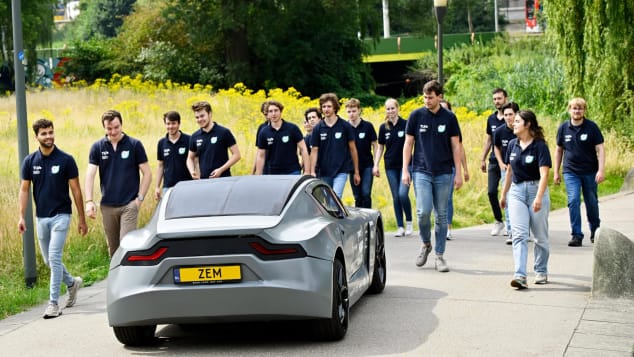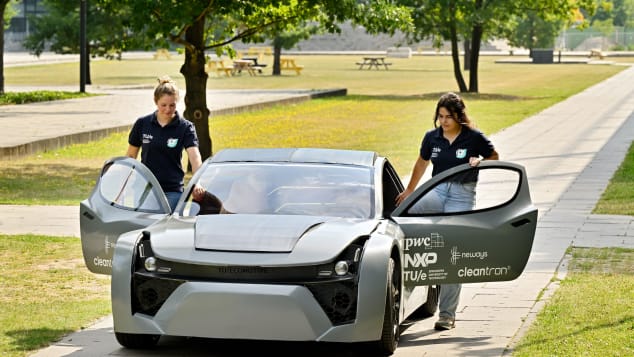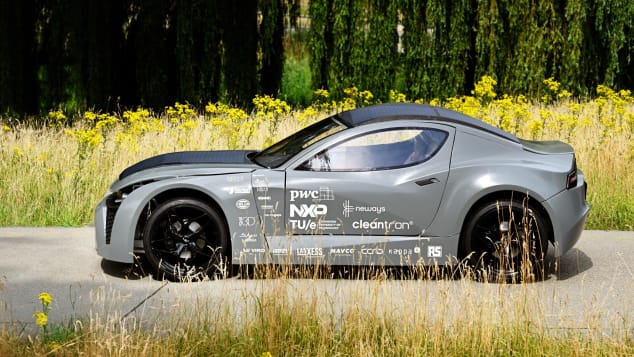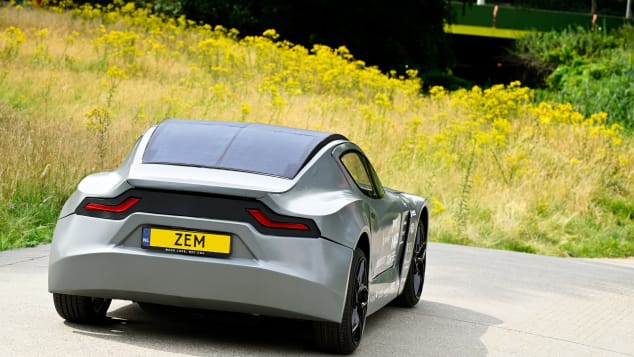Silver, sleek and sporty, Zem wouldn’t look out of place at a supercar championship. But Zem isn’t like other sports cars — or any car, for that matter.
The one-of-a-kind prototype cleans carbon from the air while driving.
Using a carbon capture device fitted to its underside, the solar-powered electric-battery vehicle absorbs and stores more CO2 than it emits. To cut waste and production emissions, the body and frame are 3D-printed using recycled plastic, and the interior is fitted out in vegan leather made from pineapples.
This sci-fi creation was devised and built by a team of 35 students at Eindhoven University of Technology in the Netherlands, as part of its ongoing TU/ecomotive project, which sees students create concept cars based on innovative technologies.
“We have implemented so many technologies into one car to really show what it can all do together,” says Louise de Laat, team manager of the project.
In the future, the students hope their carbon capture technology could be retrofitted onto existing vehicles, and help combat some of the emissions from the one billion passenger cars currently on the world’s roads.

The team of 35 students took nine months to develop the car, completing it in May 2022.
Bart van Overbeeke
A carbon-eating contraption
Since 2013, TU/ecomotive has invited students from different disciplines to collaborate on year-long innovation projects to build sustainable vehicles.
The 2021 team’s goal was “zero emissions mobility,” which gave the car its name: Zem.
Incorporating multiple technologies from partner sponsors — such as lithium-ion batteries from Dutch company Cleantron and solar panels from Watllab that provide up to 15% of the car’s charge — the student team is conducting a lifecycle analysis with SimaPro software to calculate the carbon emissions for construction, use, and afterlife of the car.
Realizing carbon neutrality was impossible to achieve, the team set out to find a way to remove carbon from the air instead.
Zem has two filters beneath the car, beside each of the front wheels. Air passes through the filter while the car is driving, and CO2 sticks to a special grain inside the filter. The filter needs to be emptied every 200 miles, so the students designed a custom EV charging station where the CO2 can be extracted from it. It can then be reused in the production of other fuels, such as clean hydrogen, or stored underground in geological formations to keep the CO2 out of the atmosphere.
While the device helps to offset some of Zem’s production emissions, it’s still small scale. Currently, the filters only capture 2 kilograms (4.41 lb) of CO2 every 20,000 miles — that’s less than a tenth of the CO2 the average tree absorbs annually, and 0.04% of a typical vehicle’s yearly emissions.
However, the team’s device demonstrates a proof of concept. The students are currently applying for a patent, and Laat is planning to develop and improve the carbon capture technology in a spin-off startup.

Zem is 3D-printed using recycled plastic strengthened with either glass fibers or carbon fibers, which the students say cuts material waste.
Bart van Overbeeke
‘Moonshot thinking’
While carbon capture technology is vital to remove CO2 from the atmosphere, its development has been slow. In 2020, 44 million tons of CO2 were captured — just 13% of the target, according to the International Energy Agency.
But there’s growing interest in this space. Entrepreneurs like Elon Musk are investing heavily in carbon capture innovation prizes, and carbon capture and storage is projected to be a $7 billion industry by 2028.
The amount of CO2 the student’s device captures may be limited — but this prototype is an important first step, says Carlo van de Weijer, a research fellow at Eindhoven University of Technology.
Van de Weijer has spent decades working in the automotive industry, including executive positions at Siemens and TomTom, and has been a mentor to the innovation teams at Eindhoven for years.
“If you consider that we’ll never be a 100% fossil fuel-free, or at least, carbon-emitting free economy, then we have to get (CO2) back out of the air,” says van de Weijer.
The EV revolution has reduced emissions at the tailpipe, but those created during the production of vehicles are still a growing problem. According to a 2021 report from the non-profit International Council of Clean Transportation, manufacturing a medium-sized EV in Europe generates two metric tons more in CO2 equivalent than a conventional car.

Two carbon capture filters beneath the car trap and store CO2, helping to offset the vehicles driving and production emissions.
Bart van Overbeeke
Van de Weijer describes the goal of zero-emissions mobility as “audacious, moonshot thinking” but says that wild ideas often lead to brilliant breakthroughs. If the team’s carbon capture technology is scalable, he says that not only could it be retrofitted onto cars, but it could work as a standalone, stationary technology.
“We have gigantic challenges for the future with the environment,” says van de Weijer. “If something comes out of (Zem) as a spin-off, thenw it would be fantastic — it can contribute to this huge problem.”
Innovators vs. industry
The team finished building the car in May this year and began a tour across the US in August. The US is the world’s second-biggest emitter of greenhouse gases and first per capita — and nearly a third of these emissions come from transport. That’s why the Netherlands-based team chose to tour there instead of Europe, says Nikki Okkels, the external relations manager for TU/ecomotive.
“We hope we can push forward more examples like Zem because we recognize that the industry is moving slowly in sustainability,” says Okkels. Traveling from San Francisco to New York, the team met with major automotive companies along the way, which Okkels hopes can spur the industry to move closer to net zero.

Zem isn’t road legal yet — but Louise de Laat says the next student team will work to overcome some of these regulatory challenges.
Bart van Overbeeke
“We pulled it off: 35 students with a lot of eagerness but a lot less experience than the main industry that we are competing with,” says Okkels, adding that without regulatory restrictions faced by big companies, they have more room to experiment. “We’re just showing the big industry what is possible.”
Unfortunately, the team couldn’t drive Zem on its US road trip: 3D-printed vehicles are not road legal, so the car had to be towed on a trailer. “The next team will be working together with (road authorities) in this process, and maybe we’ll be able to make a road-legal car in the future,” says Laat.
Zem finishes its US tour in October and returns to Europe, where future student teams will continue evolving the concept to one day get a fully carbon-neutral vehicle on the road.
For now, Laat is pushing on with her dream of spinning out the carbon capture technology — and hopes it could help to avert a climate catastrophe.
“Imagine if you could implement this (device) on all those other vehicles around the world,” says Laat. “And maybe not only cars, but even trains, big trucks, ships, or airplanes. There are so many possibilities.”

